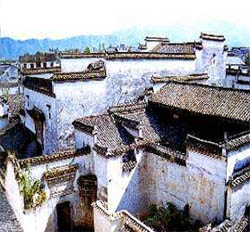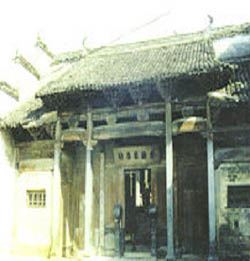1) ancient living houses


古代民居
1.
The Hierarchical system for ancient living houses in China is a materialized form, in which the ruling class tried to establish its ideal and social order.
中国古代民居建筑等级制度,是统治阶级试图创设理想社会秩序的物化形式。
2) ancient inhabitant


古代居民
1.
1 cemetery of Qiongkeke at Nilka County, Xinjiang, the paper points out that meat is the main component in the food structure of the ancient inhabitants in this cemetery while C3 plants account for a large portion in vegetable food.
本文对新疆尼勒克县穷科克一号墓地出土人骨中C、N同位素的比值进行了测定,结果显示,该墓地古代居民的饮食结构中以肉食类为主,植物类食物中以C类植物为主。
3) Ancient houses


古民居
1.
A study on the major characters of ancient houses in Huizhou area in terms of Folklore;


从民俗学角度看徽州古民居的主要特点
2.
The architecture of ancient houses of Huizhou has brought about a splendid perspective during the past several hundred years because of its unique geographical environment and economic surroundings.
徽州古民居建筑因其所处的独特的地理环境和经济环境及拥有的文化价值 ,至今仍熠熠生辉。
4) ancient dwelling


古民居
1.
Exploring the artistic characteristics of Peitian ancient dwellings;


探析培田古民居艺术特征
2.
The research on the tourism development of ancient dwelling during regional planning


区域性规划中对古民居旅游开发的研究
6) old residences


民族古居
补充资料:安徽民居
安徽民居其布局一般都以三合院或四合院为基本单位,但宏观世界与北京的院落形式有别。根据当地气候、地 形的特点,安徽传统的民居建筑多为各种造型的二层楼房,有的依山傍水,有的参差起伏,有的层楼叠院,精致朴素、堂皇俊秀。
形的特点,安徽传统的民居建筑多为各种造型的二层楼房,有的依山傍水,有的参差起伏,有的层楼叠院,精致朴素、堂皇俊秀。
安徽民居代表西递村简介
西递村位于安徽省黄山市黟县东南部,四面环山,两条溪流从村北、村东经过村落在村南会源桥汇聚。现存明、清古民居124幢,祠堂3幢。2000年11月30日,被联合国教科文组织列入世界文化遗产名录。
西递村是一处以宗族血缘关系为纽带,胡姓聚族而居的古村落,该村源于公元11世纪,发展鼎盛于14-19世纪。20世纪初,随着我国封建宗法制度的解体,西递村的发展也日趋缓慢。由于历史上较少受到战乱的侵袭,也未受到经济发展的冲击,村落原始形态保存完好,保持着历史发展的真实性和完整性。 
西递村以一条纵向的街道和两条沿溪的道路为主要骨架,构成东向为主、向南北延伸的村落街巷系统。所有街巷均以黟县青石铺地,古建筑为木结构、砖墙维护,木雕、石雕、砖雕丰富多彩,巷道、溪流、建筑布局相宜。村落空间变化韵味有致,建筑色调朴素淡雅,体现了皖南古村落人居环境营造方面的杰出才能和成就,具有很高的历史、艺术价值。西递的石、砖、木三雕,堪称西递三绝。